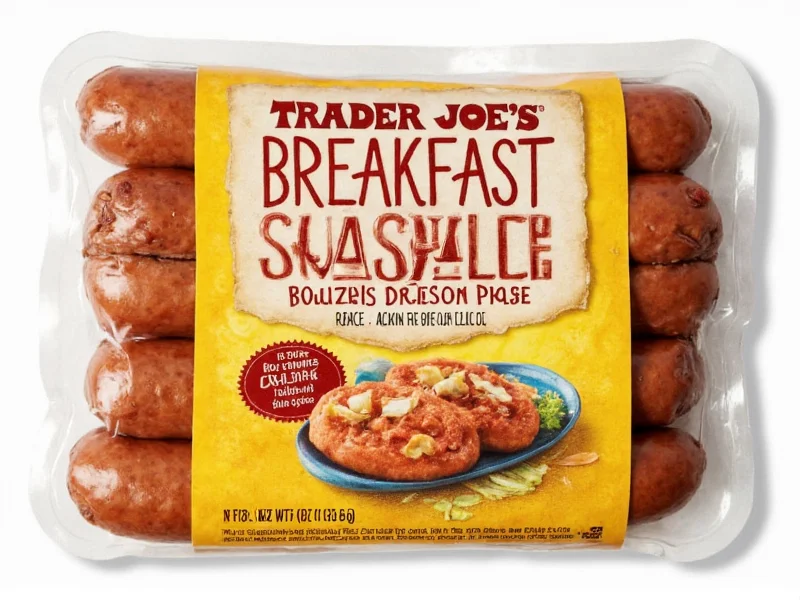Understanding Trader Joe's Breakfast Sausage Options
Trader Joe's has built a reputation for quality private-label products, and their breakfast sausage lineup exemplifies this commitment. Unlike mass-market grocery store sausages, Trader Joe's formulations focus on simpler ingredient lists without artificial preservatives or colors. The supermarket chain offers several distinct varieties that cater to different dietary preferences while maintaining consistent quality standards.
Varieties of Trader Joe's Breakfast Sausage
Shoppers can choose from multiple breakfast sausage options depending on their dietary needs and flavor preferences. The most popular varieties include:
| Variety | Key Ingredients | Calories (per 2oz) | Dietary Notes |
|---|---|---|---|
| Original Pork Patties | Pork, water, salt, spices, natural flavors | 180 | Gluten-free |
| Turkey Breakfast Sausage | Turkey, water, salt, spices, natural flavors | 110 | Lower fat, gluten-free |
| Plant-Based Breakfast Sausage | Pea protein, expeller-pressed canola oil, water | 160 | Vegan, soy-free |
| Chicken Breakfast Sausage | Chicken, water, salt, spices, natural flavors | 120 | Gluten-free |
Ingredient Analysis and Nutritional Profile
When examining Trader Joe's breakfast sausage ingredients, the brand distinguishes itself from conventional grocery store options through cleaner formulations. The original pork variety contains just six ingredients compared to the 10-15 found in many national brands. This simplicity appeals to consumers seeking minimally processed breakfast options.
Nutritionally, the standard pork breakfast sausage provides 180 calories, 16g fat (6g saturated), 1g carbohydrate, and 9g protein per 2-ounce serving. The absence of fillers like corn syrup or artificial preservatives makes it a preferable option for those monitoring ingredient quality. The turkey and chicken varieties offer lower fat content while maintaining adequate protein levels for a satisfying morning meal.
Preparation Methods and Cooking Tips
Proper preparation significantly impacts the final texture and flavor of Trader Joe's breakfast sausage. For optimal results when cooking the pork variety:
- Thaw frozen sausage in the refrigerator overnight rather than using microwave defrost settings
- Cook over medium heat to render fat gradually without burning
- Flip patties every 2-3 minutes for even browning
- Use a meat thermometer to ensure internal temperature reaches 160°F
- Drain excess grease on paper towels after cooking
The plant-based alternative requires slightly different handling—cook over medium-low heat as higher temperatures can cause the casing to split. Unlike traditional sausage, the vegan option benefits from a light spray of oil to prevent sticking during cooking.
Taste Profile and Texture Comparison
Food enthusiasts consistently note that Trader Joe's original breakfast sausage delivers a balanced flavor profile with prominent sage and black pepper notes without overwhelming saltiness. The texture remains moist without excessive greasiness when prepared correctly—a common complaint with many supermarket sausage brands.
When comparing Trader Joe's offerings to national brands like Johnsonville or Jimmy Dean:
- Trader Joe's contains fewer ingredients and no artificial preservatives
- The fat content is comparable but renders more cleanly during cooking
- Flavor notes are more herb-forward rather than salt-dominant
- Pricing averages 15-20% lower than premium national brands
Creative Recipe Applications
While excellent as a standalone breakfast item, Trader Joe's breakfast sausage shines in various culinary applications. Home cooks have developed numerous creative uses that extend beyond traditional morning meals:
- Sausage and Sweet Potato Hash: Combine crumbled cooked sausage with roasted sweet potatoes, onions, and bell peppers for a nutrient-dense brunch option
- Breakfast Casserole: Layer sausage patties with eggs, cheese, and vegetables in a baking dish for meal prep
- Sausage-Stuffed Peppers: Mix cooked sausage with rice and vegetables, then stuff into bell peppers for a savory dinner
- Breakfast Pizza: Use sausage as a topping on whole wheat pizza crust with eggs and cheese
Storage Recommendations and Shelf Life
Proper storage maintains both food safety and optimal texture. Unopened packages remain fresh in the refrigerator for 3-5 days past the 'sell by' date. For extended storage, freeze unopened packages for up to 3 months. When freezing opened packages, divide into meal-sized portions and use heavy-duty freezer bags to prevent freezer burn.
Thaw frozen sausage in the refrigerator for 24 hours before cooking—never at room temperature. Cooked sausage keeps refrigerated for 3-4 days or frozen for 2-3 months. The plant-based variety follows similar storage guidelines but has a slightly shorter refrigerator shelf life once opened (2-3 days).
Value Assessment and Availability
At $3.99-$4.99 for a 12-ounce package, Trader Joe's breakfast sausage offers competitive value compared to both conventional and premium grocery store options. The price per ounce falls between mass-market brands and high-end butcher shop sausages, making it an economical choice for quality-conscious shoppers.
Availability remains consistent across Trader Joe's locations nationwide, though regional variations occasionally affect specific varieties. The original pork sausage maintains year-round availability, while specialty varieties like maple-flavored or hot Italian may appear seasonally. Most stores stock breakfast sausage in the refrigerated meat section near other private-label protein options.
Frequently Asked Questions
Does Trader Joe's breakfast sausage contain nitrates or nitrites?
Trader Joe's original pork breakfast sausage does not contain added nitrates or nitrites. The ingredient list includes only pork, water, salt, spices, and natural flavors. Always check the specific product label as formulations may change over time.
How long does Trader Joe's breakfast sausage last in the refrigerator?
Unopened packages remain fresh for 3-5 days past the 'sell by' date when kept refrigerated at or below 40°F. Once opened, consume within 1-2 days for optimal quality and safety.
Is Trader Joe's breakfast sausage gluten-free?
Yes, the original pork, turkey, and chicken breakfast sausage varieties are certified gluten-free. The plant-based option is also gluten-free. Always verify by checking the current product label as formulations can change.
What's the best way to cook Trader Joe's breakfast sausage patties?
For optimal results, cook patties over medium heat for 8-10 minutes, flipping every 2-3 minutes until they reach an internal temperature of 160°F. Avoid high heat which can cause burning before the interior cooks through.











 浙公网安备
33010002000092号
浙公网安备
33010002000092号 浙B2-20120091-4
浙B2-20120091-4